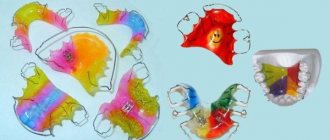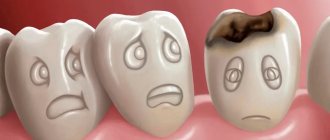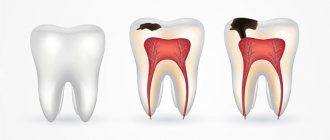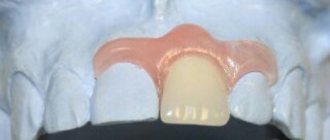Almost the entire population of the planet today knows what caries is - according to the World Health Organization, this disease occurs in 90% of people. But the most dangerous thing is that caries is actively spreading among young patients, whose age barely reaches 2-3 years. At the same time, most parents are in no hurry to take their children to the doctor, thinking that there is no need to treat baby teeth, since they will soon fall out, and new, healthy and beautiful permanent ones will grow in their place.
The most common dental diseases in children
- The first place of honor is occupied by the most common dental disease - caries. It can occur on both permanent molars and baby teeth. The peculiarity of childhood caries is that it can occur even at a very early age and spread to neighboring teeth in a short time. In addition, caries in children is mostly painless and does not cause any discomfort. Therefore, if the disease is not detected in time, it will move to the next stage - pulpitis.
- In second place is pulpitis. It occurs when caries has destroyed the tooth and reached the pulp. At this stage, pain occurs and even the temperature rises. Dentists try not to remove the pulp and baby tooth, for the proper formation and development of the child’s jaw.
- Periodontitis. An advanced form of pulpitis or trauma causes periodontitis. The infection penetrates the root of the tooth and the gums become inflamed. If you do not consult a dentist, you risk tooth loss and improper development of molars.
- Flux. A swelling forms on the gum; in the later stages, an infection develops and pus begins to accumulate. Flux occurs if you do not consult a dentist in time with caries, pulpitis or periodontitis.
- The top five most common dental diseases in children ends with malocclusion. To determine the correctness of a child’s bite, you need to take him to an orthodontist at the age of 5–6. Incorrect jaw formation can lead to periodontal disease, changes in the shape of the face, an unattractive smile and frequent visits to the dentist.
Diseases of baby teeth
Caries is an inflammation of dental tissues. It has several main stages: superficial, middle and deep. If you do not undergo annual preventive examinations, pathogenic bacteria from the carious cavity penetrate into the pulp. This causes pulpitis, or inflammation of the nerve inside the tooth. Its acute stage can quickly turn into chronic, completely unnoticed by the baby and his parents.
Unfortunately, very often pulpitis is completely asymptomatic. Therefore, if parents do not conduct at least a visual examination of the child’s oral cavity, it is quite easy to miss the disease. But still, the main alarm signal and reason to see a doctor are complaints of pain and discomfort when chewing food, tears when eating cold or hot foods, and refusal to eat. At night, the baby can also sleep restlessly, because acute pulpitis manifests itself precisely at this time.
Caries and pulpitis develop very quickly on baby teeth. A short period of time passes from one state to another if no measures have been taken. This is due to the structure of a child’s tooth – thin enamel, a small layer of dentin and a wide cavity with pulp. Therefore, be sure to show your baby to a specialist at least 3-4 times a year.
Causes of dental diseases in children
Dental disease in children is caused by many reasons:
- If the mother suffered serious illnesses during pregnancy: infectious, endocrine or rheumatism.
- If the mother smoked or drank alcohol during pregnancy and feeding.
- If the child has suffered a serious illness in the first months of life.
- Accumulation of food debris on the baby's teeth after bottle feeding.
- If the child consumes large amounts of sugar, carbohydrates, dyes.
- If the body lacks vitamins and minerals.
- Insufficient oral hygiene and prevention.
- Weakened child's immunity.
Caries and pulpitis of baby teeth: causes
It is a big misconception to believe that baby teeth do not need treatment. In addition to the fact that your baby will be haunted by pain due to carious lesions and will not be able to fully chew food, aesthetic problems will also arise after tooth extraction. But the most important thing is that by ignoring the baby’s dental problems, his parents directly influence his future bite and the correct formation of the entire dental system. That is, if a baby tooth is removed too early, the permanent one is very likely to grow abnormally.
How does it happen that even a very small person develops a number of serious dental problems? The reasons may be different:
- lack of hygiene: if you don’t brush your teeth, plaque will accumulate on them. It is this that leads to the gradual destruction of teeth, so the most basic reason for the development of caries is precisely ignoring daily tooth brushing,
- the baby is fond of sweets: everyone knows that children are big lovers of sweets, but they are in no hurry to brush their teeth after eating sweets and lollipops, and parents, in general, do not always insist on oral hygiene. This is how the process of enamel destruction begins,
- Oral infection: caries is caused by pathogenic bacteria. Their number increases noticeably when the baby puts dirty objects into his mouth. By the way, if a mother licks her child’s spoon before feeding, this also leads to the predominance of pathogenic microflora in the mouth, which increases the risk of developing caries,
- Genetics is to blame for everything: it is believed that a predisposition to oral diseases can be inherited. The baby can get the structure and strength of enamel and dentin from mom or dad,
- lack of calcium: the rudiments of teeth are formed directly in the fetus, so it is worth thinking about the baby’s teeth even during pregnancy. The expectant mother needs to eat well and take vitamin complexes,
- lack of vitamins: after birth, the baby’s food must be rich in minerals, calcium and phosphorus for the full development and formation of bone structure,
- bad habits: sucking on a bottle of formula, milk or juice at night.
How can you tell if your child has a toothache?
Dental diseases in children differ from those in adults in that there is no pain at the early stage of infection. And the process of infection spreading occurs much faster, because the enamel is thin and the tooth’s resistance to disease is low. Symptoms of dental disease in children:
- First, pay attention to the enamel of your teeth. If yellow or gray spots appear, this is the first sign to consult a dentist. He will conduct an initial examination and may find cavities that are not visible at home.
- If the child cannot calmly eat sour and sweet foods.
- Painful sensations from hot and cold water. Usually this is the stage of deep caries, in which destruction is clearly visible on the surface of the tooth.
- Tooth pain while eating.
- Fever, nausea and general weakness.
Don't be afraid to take your child to the dentist at an early age. If you carry out a preventive examination and follow the doctor’s instructions, then the baby will get used to such visits and in the future he will not have painful associations and a bad mood when mentioning the dental office.
Do baby teeth need to be treated? What are the consequences of ignoring problematic baby teeth in the future?
The doctor’s answer to this question is clear, says FAN’s .
"Of course yes. Baby teeth need to be treated! If you leave everything to chance, the child will inevitably suffer from pain and discomfort. Moreover, it is advisable not to delay this process so that the little patient does not have a negative experience in dental treatment,” explains Victoria Arutyunova.
Of course, it is better to limit ourselves to preventive measures, but if, after all, time has already been lost, then therapeutic manipulations are absolutely necessary, since the infection gets into the tooth, and then through the nerves and canals it enters the bone and ultimately can infect and damage the germ of a new tooth . If this happens, then there are several scenarios for how the situation could develop further. The rudiment may die altogether and stop developing, or the tooth may erupt with a slight visual defect. Typically, this phenomenon is called enamel hypoplasia. In addition, possible complications include swelling, periostitis, inflammation of the gums with subsequent release of infection and pus and, accordingly, painful removal and an incision to drain the exudate.
Naturally, this procedure, which is unpleasant for the child, causes persistent negativity and provokes difficulties in further interaction with the pediatric dentist.
“In addition, during such removals, anesthesia may not work well, since the infectious exudate does not allow the anesthetic to penetrate deep enough. The child will remember such a visit for a long time, so it is better to treat without leading to such complications,” says our expert.
What are the consequences of a frivolous attitude towards children's health? If you still have to remove a baby tooth, the place will be empty, and nature, as we know, does not tolerate emptiness. As a result, neighboring teeth will begin to tilt towards the missing one. As a result, the further appearance of permanent teeth will be difficult; they will erupt in the wrong position and at the wrong time, which will cause orthodontic problems. With a high degree of probability, in the near future, parents will have to seek the services of an orthodontist to correct the situation with the help of plates or braces.
pixabay.com/
How is dental treatment performed for children at the Gorod clinic?
The dentists at the Gorod clinic approach dental treatment for children very responsibly. We need to find an individual approach to each little patient so that the examination goes smoothly.
At the first appointment, a child can only be frightened by an unfamiliar environment and new people. But dentists will do everything to ensure that the child is not afraid. In addition, the clinic provides painless dental treatment for children.
- Treatment without a drill. A unique method that does not use a device that frightens not only children, but also adults. A special composition is applied to the tooth, which dissolves caries. Dead tissue is manually removed by the dentist.
- If the infection has penetrated too deeply and serious intervention is necessary, then anesthesia is used. First, the gum is lubricated with a gel that freezes the tissue for painless insertion of the needle.
- Treatment under anesthesia. If long-term dental treatment is necessary, it is best to use anesthesia. The child will not be afraid of the doctor or interfere during treatment, thus the process will be quick and painless.
Stages of treatment at the Gorod clinic:
- Examination by a dentist.
- Use anesthesia if necessary.
- Cleaning the tooth from dead tissue.
- Filling.
Periodontitis and periodontal disease in children
Let's start with the fact that periodontal disease is a dystrophic disease. According to our expert, in modern pediatric dentistry this concept is already moving away. As for periodontitis, it actually occurs in children, the reason for this is insufficient oral hygiene.
“Due to the fact that children do not cope well with brushing their teeth, plaque forms on them, which gradually turns into tartar - so to speak, a single conglomerate that is not possible to clean off on your own,” says Victoria Arutyunova.
If you regularly visit the dentist and carry out professional oral hygiene on time, the problem can be identified at an early stage and first prevent gingivitis, and then, as a consequence, periodontitis, which is an inflammatory disease. First, the stone appears above the gum, then it begins to multiply and goes under the gum. As soon as this happens, under the influence of infectious agents, inflammation begins in the soft tissues, they sag, expose the roots, and periodontitis appears.
The main method of control is to visit the dentist in a timely manner for professional hygiene. If the oral cavity is in poor condition, then visits to the dentist become more frequent. Then, instead of seeing each other once every six months, the doctor and patient meet once every three months to monitor the process and correct the current situation. If children have bad habits such as thumb sucking or reluctance to give up pacifiers, this provokes receding gums.
flickr.com/
Is caries prevention necessary in childhood?
The task of parents is to keep their child’s smile healthy and beautiful, as well as to develop the habit of regularly visiting the dentist and not being afraid.
Prevention is also possible at home
- After the birth of a child, pay attention to oral hygiene; even at an early age, so-called bottle caries can appear.
- Choose your child's diet wisely. It must include dairy products, fish and fruits.
- Toothpaste should be enriched with fluoride.
- Parents need to control the amount of sweets and starchy foods.
- Make sure your child brushes his teeth 2 times a day.
In addition to prevention at home, it is necessary to be examined by a pediatric dentist twice a year. After all, an undetected disease develops into a complex form in time, which will bring a lot of stress, trouble and pain to your child.
Don't delay treatment
Make an appointment with a dentist by phone: +7 or or leave a request on the website:
Make an appointment
Main dental diseases in children
The first year of a child’s life can also present surprises to parents in the form of oral diseases. Most often, these are injuries to the oral mucosa, which still has a very delicate structure that can be easily damaged even by a soft pacifier. There is also a danger of developing fungal diseases or the appearance of herpetic stomatitis, sometimes even recurrent.
Do I need to treat rotten teeth?
Of course, it is necessary to treat any damage to baby teeth. The loss of one or more milk units can affect the correct formation of the bite in later life. In addition, the destruction of hard tissues inevitably leads to inflammatory processes in the surrounding soft tissues. If you do not deal with the problem in a timely manner, then there is a high risk of developing an abscess, meningitis, sepsis, etc.
Quite often, dental caries does not manifest itself in any way until the child’s immune system is weakened due to illness or a common cold. The consequences can be quite serious: sinusitis, pain in the ears (otitis and other problems), digestive problems, intestinal disorders and stool disorders, as well as severe stomach pain.
In addition, rotten teeth look very unsightly even in a child. Older children may begin to feel complex about their appearance; they will develop self-doubt and tightness. That is why it is very important to periodically check the condition of your baby’s teeth, because it is much easier to eliminate the problem at an early stage.
previous post
The difference between paid and free anesthesia
next entry
Filling or silver plating
Silver ions stop the growth and division of pathogenic microorganisms. This means that caries will not develop in the future. But silvering is prescribed only in the initial stages of the disease. When large areas are damaged, it is useless to silver a baby tooth; over time, it will still collapse. A puncture may occur, which certainly will not be pleasant for the baby.
Is it possible to do a filling without a drill?
Today, medicine has made great progress and dentistry is no exception. Our clinic has ultra-modern equipment that does not produce frightening noisy sounds. In addition, filling is currently performed chemically. Its essence is the application of a special gel-like substance, which, after 30 minutes of exposure, is removed along with the damaged tissues. Then filling material is applied to this place.
Anesthesia
In order not to traumatize the psyche of children, dentists use injections extremely rarely. Pain-relieving gels and sprays are mainly used. Injection anesthesia is used only in extreme cases.
Anesthetics are selected in each individual case and are used only when there are no contraindications.
Causes of caries
- artificial feeding;
- genetic predisposition;
- poor nutrition (lack of sufficient fluoride in the diet),
- injuries;
- defects, features of the anatomical structure of bone tissue;
- poor oral hygiene;
If the development of the disease is associated with inheritance or poor health, it is necessary to regularly show the child to the pediatric dentist.
The post Filling baby teeth appeared first on.
]]>
Symptoms of caries
The symptomatic picture of caries of primary molars directly depends on the volume of dystrophic or infectious lesions in children's teeth. In particular, there are four forms of the disease:
- initial;
- superficial;
- average;
- deep.
Stage 1 of caries development
It is characterized by the formation of white spots on the enamel of different shapes and sizes, which do not cause discomfort to the baby. If left untreated, these spots change color to black or brown. The development of caries is accompanied by the appearance of a cavity on the surface of the affected tooth that does not extend beyond the enamel. At this stage, the child may experience acute toothache when eating sweet and sour foods.
Average caries
It is characterized by a deepening of the resulting cavity, the appearance of toothaches when in contact with icy or too hot food. With deep carious lesions and the progression of pulpitis, the tooth succumbs to enormous destruction and loses the ability to fully perform its immediate functions. Children suffering from deep caries complain of severe toothache, which becomes more pronounced when eating, as well as a slight deterioration in their general condition.
Stay vigilant
If you find plaque forming on your child’s teeth that you are unable to remove on your own, as well as brown or white spots, this indicates that the child urgently needs to be shown to a pediatric dentist. If the baby complains of discomfort that occurs when eating hot or cold food, this indicates the spread of caries into the deeper layers of the tooth. Parents should never ignore such complaints. It happens that a small child is not able to clearly communicate what is bothering him, so if he refuses food or a certain type of food, and also chews on one side, this may indicate toothache.
Features of filling
Our dentists use a variety of treatment options, starting from a very young age. Doctors use treatment approaches that do not cause mental trauma to children.
Installing fillings on milk bone tissue is practically no different from filling adults.
What materials are used
- Amalgam.
- Glass ionomer cement.
- Composites (combined filling).
Advantages of breast filling
- Filled baby teeth look aesthetically pleasing and are visually indistinguishable from natural ones.
- After filling, baby teeth are reliably protected from pathogenic infection; it will not penetrate into the bone tissue.
- Thanks to modern filling materials, even large cavities of destruction can be restored.
Colored fillings
This modern method of breast bone tissue restoration was developed specifically for the treatment of children. The fear and tears of children in front of dentists are replaced by interest when doctors offer children to get such fillings. All kids love bright, beautiful fillings and teeth painted in all the colors of the rainbow. They can choose their own color.
In addition, funny fillings have one advantage - they release fluoride ions, which prevents the development of secondary caries in the future.
The advantages of colored material include:
- eight spectacular, brilliant and bright colors that will not leave any child indifferent;
- fillings are perfectly polished;
- prevention of caries;
- the material is strong, so you won’t need to worry before replacing baby teeth with permanent ones;
- anti-allergenic and safe for children.
Reasons for the development of childhood caries
Main risk factors:
- Excessive consumption of sweets. In this case, a harmful environment is formed in the child’s mouth, and the tooth enamel begins to suffer.
- Transmission of infection from relatives. This can happen when sharing utensils, adults licking a baby's spoon, and sometimes even kissing.
- Long contact with the bottle. This type of caries is called “bottle caries”. If a baby drinks a sweet liquid from a bottle and then falls asleep with it, then prolonged contact of the sweet with the teeth can lead to the rapid development of caries.
- Deficiency of fluoride and calcium in food.
- Lack of solid food. When chewing solid food, a lot of saliva is released, which naturally washes the oral cavity.
- The use of medications that change the composition of saliva.
- Chronic diseases.
- Improper care of baby teeth. Infants need to wipe their teeth from the moment they erupt - you can use ordinary gauze wrapped around your finger. It is very important for parents to teach older children to brush their teeth and use a brush, constantly remind them of this and monitor compliance with the procedures. The example of parents is a strong motivating factor here.











